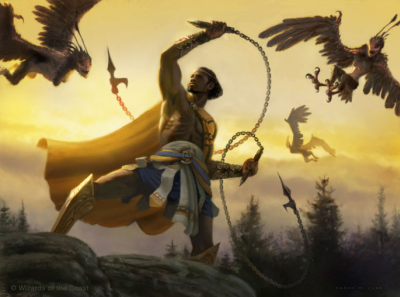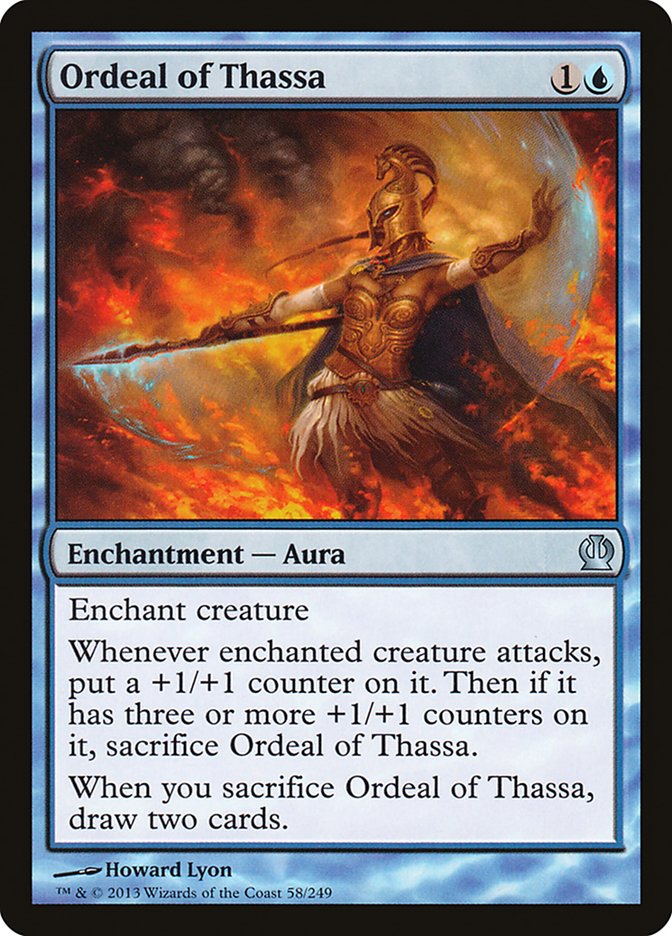Looking over the spoiler of a new set is one of the most exciting experiences Magic players enjoy throughout the year. The spoiler oozes with potential. An old practice I managed to keep up season to season was scanning the set for the breakout Limited treasures. This changes from set to set; using Theros as a recent example, cards like Lightning Strike, Feral Invocation, and Celestial Archon are solid foundations of Limited sets, and taking them is almost always a given. Cycles provide an interesting way to view a mechanic and to showcase the theme and flavor of a color, and the most recent cycle of theme-centric cards have been the Ordeals.
The Ordeals were designed as heroic enablers that go alongside the enchantment theme of the Theros world. Symbolic of the quests undertaken by the gods’ champions, they bear a striking similarity to the Expedition cycle found in Theros.
"A striking similarity."
The Expedition cycle displayed a quantifiable relationship between the colors and their role in the new plane. These cycles are never meant to be furiously competitive or earth shattering in power, but they are there to immerse you in the flavor of the world, whether you’re seeking answers to the mysteries of the hedrons in old ruins or delving deep into a labyrinth to slay the minotaur.
Short of Khalni Heart Expedition and Zektar Shrine Expedition, most of the Expeditions dwindled away into obscurity. The Ordeals currently enjoy nothing.
The Ordeal cycle intrigued me first because of its possible synergy with +1/+1 counters; Fathom Mage, my go-to counter lady in Standard, was first on the list, followed closely by Corpsejack Menace and Kalonian Hydra. I fiddled with the Ordeals in this capacity but found something out. The Ordeals are very bad Magic cards. Often the effect is too minimal and/or too much work by the time you get there. Consider Ordeal of Erebos. You could play Mind Rot for one more mana and get its effect immediately. Or you can swing for three turns safely and hope your creature survives beyond its final trigger. Yeah, I’m not very sold.
Standard turned out to be an underwhelming proving ground for the Ordeals. The format was too fast, and the creatures you could target still died to so much; I wasn’t about to give up though. Theros, as good a set for competitive and mainstream Standard as it is, doesn’t leave much for my wild brewing mind to digest. There had to be something here.
The Ordeals’ triggers are separate. Ordeals do not care how they are sacrificed to use their effect, only that they are sacrificed (as opposed to being put in the graveyard or some nonsense). Therefore, any ability that can sacrifice them allows you to reap this trigger. One card in particular makes that happen without regard for color.
This free artifact offers a repeatable, slightly positive exchange of resources. Slapping an Ordeal on any able creature then sacrificing the Aura yields the full reward right away. Is it worth it? Let’s deal with these Ordeals and see what we can find.
Creatures (16)
Lands (20)
Spells (24)

There’s a lot to digest, so let’s look at the creature base first.
Aura Targets: Kor Spiritdancer, Slippery Bogle, & Gatherer of Graces
Modern is no stranger to Auras. "All-in" Auras decks have been popular for some time, and Kor Spiritdancer is at the heart of this deck. This Verduran Enchantress replaces each Aura cast and grows with each one you choose to attach to her. Drawing and applying as many Auras as possible is essential to a successful game, and it keeps the party going. Slippery Bogle likewise is a known enemy in Modern. This easier-to-cast Gladecover Scout gives you a safe, tidy target for your plethora of Ordeals on curve. Open up with the Bogle and attach away. Attaching a second Ordeal on turn 3 means that both will go off on attack, which can be pretty exciting!
Gatherer of Graces is actually a better sacrifice outlet than Claws of Gix, offering a free and more beneficial alternative. This Druid is easier to kill and more expensive to cast than the Claws, but it is an effective—albeit narrow—option. Lastly, Birds of Paradise and Nomad Mythmakers provide essential fixing and sustained value respectively. The Nomad resurrects and reattaches one Aura a turn to help you get maximum value out of each.
Ordeals
Over a quarter of the deck is dedicated to Theros’ Ordeals, and it will put a smile on your face every time you cast one. These Ordeals were chosen to provide the most value for the money; Ordeal of Nylea, the only one absent, has its place too, as you’ll see later. All of the Ordeals represented play essential roles throughout the game. Ordeal of Heliod offers a very healthy boost of life, and Ordeal of Erebos is great for slimming down a thick grip. Even Ordeal of Purphoros—a glorified and harder to activate Searing Spear—has potential when you can rebuy it and/or sacrifice it for no mana investment.
Rancor
Ah, Rancor. Just when we thought we could escape your sultry format-defining charms, you reel us right back in.
Much like in the Auras decks of the past year, Rancor provides an absolutely essential piece to making everything work. It lets you regenerate your Gatherer for free, it can be cycled indefinitely in tandem with Kor Spiritdancers, and it provides reach when you’re trying to wade through a sea of blockers. What can I say; Rancor is the perfect enchant creature.
Utility: Claws of Gix, Perilous Research, & Cloud Key
For the low price of two mana, two cards and an Ordeal effect can be yours! This one-sided Vision Skeins provides nearly constant support for the auramancer on the go. Kindled by my fondness for the long-derelict Perilous Research and Hatching Plans, this kind of interaction turbocharges your hand. Cloud Key reduces the cost of each Ordeal to just one of its color, making it easier than ever to load up a target with spicy Ordeals.
Ok, the lands are a mess. From my experience, Modern mana bases are generally a mess. I don’t know about you, but one of the biggest pains about Eternal formats is deriving a correct mana base based on the demands of your deck and the effect it has on your life total. I don’t like having sixteen unique land names in the midst of twenty lands! In a five-color deck, however, sacrifices need to be made, and this is the cost of going deep.
Sideboard
Naturally, the sideboard is shaky, but as you can see, Seal of Primordium is featured prominently. In my experience, most tricky ways for decks to manage unusual or combo-oriented decks involve enchantments. Leyline of the Void, Ghostly Prison, and even an errant Oblivion Ring or two can throw a magic monkey wrench (this is Magic after all) into your plan. Seal provides outs to most every artifact and enchantment you might encounter, and you can store ahead of time when you really need it.
The rest of the all-enchantment sideboard is wild conjectures on what I might need given a certain situation. Ghostly Prison for aggro, Illness in the ranks to deal with Young Pyromancer or Forbidden Orchard tokens, and Runed Halo to answer Liliana of the Veil and other edict effects. You know how this goes by now; sideboards are products of understanding what beats you and what the metagame reflects.
Now, my original version of this deck did run Ordeal of Nylea, and thanks to a basic-centric mana base, the deck was much friendlier to the wallet. If you’re interested in taking the deck out for a spin but want to keep from selling an organ, check out the list below.
Creatures (17)
Lands (20)
Spells (23)

Depending on how you price this out, you’re looking at just under $100 for a fun and interesting Modern deck (even the sideboard from the full version costs just over $35 to put together.)
So how does the deck play? Well, it depends. Blue decks gave me significant trouble; bounce and counters were often cheap enough to put me off my game pretty well. The deck handled discard well considering, and aggro was down the middle; must-answer creatures like Tarmogoyf and Geist of Saint Traft proved to be problematic but not unsolvable. One thing that’s important to remember is that when you’re Ordealing up a creature, they get pretty big in the process, making them even against high-level creatures. Recycling Ordeal of Heliod kept me in the game against heavy onslaughts. One of the format’s boogeymen, Deathrite Shaman, also has very few targets in this deck, giving me lasting power against the slow drain.
It still needs some refinement and the mana is lousy of course, but the deck is really fun to play and is surprisingly interactive. If your shop has a Modern scene you’ve been looking to tap into, give it a whirl and make adjustments based on the needs of your metagame. Modern is a great middle ground between Legacy and Standard, and I hope more support arises on the large and smell levels of sanctioned Magic.

Now that Magic Online has caught up to paper Magic, Block Constructed will shortly become a thing. If you’re prepping for PTQs in spring 2014 and want to know more about the format you’ll be exploring in Atlanta, it might not hurt to give it a glance right now.
Although I haven’t been brewing for Block Constructed as much as I normally do, it’s still an exciting environment. Lower-power decks and strategies get to shine, and it’s easier for new players to hop in. My most promising brew, which I tried to port to Standard before realizing its futility, bases itself on the heroic mechanic the Ordeals plan to augment. I’ve combined the best heroic creatures into a synergetic build of small instants and considerable pressure to make this list. See what you think!
Creatures (20)
- 4 Phalanx Leader
- 4 Artisan of Forms
- 4 Battlewise Hoplite
- 1 Triton Fortune Hunter
- 3 Agent of the Fates
- 4 Fabled Hero
Lands (22)
Spells (18)

I’ve got a Grand Prix coming to my neighborhood in two weeks, and I’ll be testing wildly for that. Next week I want to bring you two decks that I didn’t build but am happy to offer to you as a sign that you, Mr. or Ms. Brewer, are not alone. A merry week to you, and until next time, don’t forget to untap!
– Matt
CaptainShapiro on Magic Online




